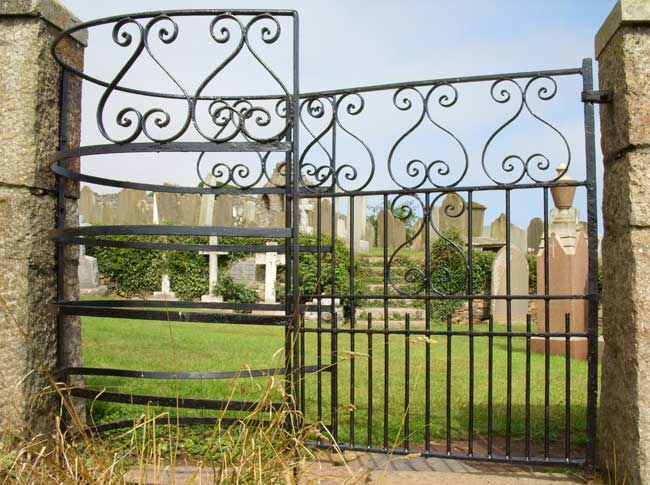Location
Cowie is in the north east of Stonehaven. The kirkyard is east of the golf course clubhouse.
Cowie, Stonehaven
OS Map Reference
NO 884 874
Description
The old kirk now stands as a consolidated ruin, originally dedicated to St. Nechtan, or St. Nathlan, though it was rededicated to St. Mary in 1276. It was never a parish kirk and was suppressed by the kirk session in the 1560s.
The kirk was lengthened at the W. end during renovations in the 15th - century, though the remainder of the kirk is said to be 13th – century in date. Restoration work was carried out in 1870 and it is probable that the lintel to the arched opening in the S. elevation dates from that time.
The E. and W. gables remain, the former composed of three lancet windows, very thin in proportion, broadly spaced and having carved sandstone head terminals. The gable wall is extremely deep with the windows having a remarkably broad internal splay. The W. gable features a large square window opening.The mort-house or arched vault was built in 1842 though the W. end of the kirk extends over this arch making it impossible to see how the vault was entered. The granite side and grassed roof of the vault appear to be in good order.
Tombstones : There are approximately 20 recumbent tombstones of which 4 are significantly well-decorated. There are many hundreds of upright tombstones contained within the kirkyard that is itself located on two levels. The kirkyard is approximately oval in shape and is situated on the cliffs with commanding views over the North Sea.
The bottom photograph shows the wrought iron 'kissing gate'.
Related Information
St. Nathalan, or St. Nachlan, is reputed to have built the first small chapel on the windswept clifftop at Cowie sometime during the 7th century.
A fragment of the wall of Cowie Castle (some 200 metres to the south) and the ruined chapel are the sole remains of the Royal Burgh of Cowie, a township once of greater importance than Stonehaven. Within the Kirkyard is the ruin of the chapel of St. Mary and St. Nathalan, often known as the Chapel of Our Lady of the Storms. It probably stands on the same site as St. Nathalan's early church.The chapel was build of whinstone in the 13th century. It fell into disuse soon after the Reformation.
Within the sheltering walls of the kirkyard rest many who depended on the sea for their livelihood. Numerous tombstones, some adorned with ships and anchors, stand in memory of seamen and fishermen, many of whom lost their lives at sea.
Scattered throughout the kirkyard are headstones which display symbols of mortality.
The unusual symbol of a winged hourglass may be seen on a badly eroded 18th century stone within the ruined chapel.
There are also excellent examples of trade symbols, such as the crown and hammer of the blacksmith, the crown and last of the shoemaker, a three-masted ship of the merchant seaman, the boat of the fisherman, and the ploughshare and coulter of the farmer.
Era
Medieval
Information Source
Source The Historic Kirkyards of Aberdeenshire A Survey Report, Aberdeenshire Council 1998
and Info from Aberdeenshire information board in the Kirkyard.
Related Artefacts
- Cowie Chapel Child's Memorial Book
- Cowie Chapel farmers's tombs
- Cowie Chapel Gardner tomb
- Cowie Chapel George Ironside tomb
- Cowie Chapel Headstone with Finger Pointing Up
- Cowie Chapel lifeboat memorial
- Cowie Chapel Masonic headstone
- Cowie Chapel seamen's tombs
- Cowie Chapel winged hourglass headstone
- Cowie Chapel, 18th century blacksmith's headstone
- Cowie Chapel, 18th century shoemaker's headstone
- Cowie Chapel, Hassell tomb
Categories
Photographer
- Martyn Gorman
Unavailable Data
- Date
- Iconography
- Creator
- External Links
This content was submitted by external contributors and does not necessarily reflect the views of the University of Aberdeen.



